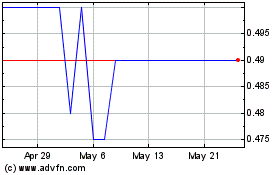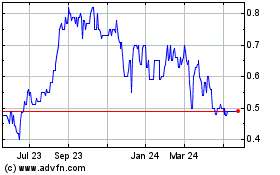Cynapsus Announces Interim Summary Results of Human Healthy Volunteer Single 25mg Study for APL-130277
28 March 2014 - 9:00PM
Marketwired Canada
Cynapsus Therapeutics Inc. (TSX VENTURE:CTH)(OTCQX:CYNAF), a specialty
pharmaceutical company, today announced positive interim data from its recently
completed healthy volunteer pilot study of a single 25mg sublingual strip
(APL-130277) dose of apomorphine. APL-130277 is an easy-to-administer,
fast-acting reformulation of apomorphine, which is the only approved drug (in
the United States, Europe, Japan and other countries) to rescue patients from
"off" episodes. The interim CTH-104 study results indicate that a higher load of
drug on the strip does result in a higher amount of drug entering the blood
stream.
Mr. Anthony Giovinazzo, President and CEO of Cynapsus commented, "Results from
the first group of subjects of the CTH-104 clinical study are an important
de-risking event for our product and set the stage for identifying efficacious
doses for our upcoming clinical studies in 2014. We are encouraged that the 25mg
strip was safe and well tolerated. Further, a significantly higher amount of
drug accumulated in the blood stream as compared to the 10mg and 15mg strips
that were tested in our CTH-103 study. This interim data shows that the
APL-130277 strip can provide a concentration of apomorphine in the blood
associated with an expected minimum efficacious concentration (i.e.
approximately 3ng/ml) for over 2 hours, therefore potentially providing a
significant reversal of the "off" state for patients with Parkinson's disease."
Dr. Albert Agro, Chief Medical Officer at Cynapsus, also commented: "The early
PK and safety data from CTH-104 confirms that our formulation has both the
potential for clinical efficacy and safety advantages over the sub-cutaneous
injection of apomorphine. We look forward to the initiation of the upcoming
clinical program assessing the effectiveness of APL-130277 in patients with
Parkinson's disease."
CTH-104 Clinical Trial Design and Results
Background
As reported on January 13, 2104, the third cohort of the CTH-103 study was
designed to compare the 25mg sublingual thin film strip (APL-130277) to the 4mg
subcutaneous injection. This third cohort could not be dosed due to the
dose-limiting adverse events experienced with the 3mg subcutaneous injection.
The 15mg sublingual strip (APL-130277), which was the corresponding dose to the
3mg subcutaneous injection, resulted in side effects that were mild-to-moderate
and not dose limiting.
The current CTH-104 study is a single dose, single arm, placebo-controlled,
healthy volunteer pharmacokinetic study, which is designed to examine the
pharmacokinetic profile of the 25mg dose of APL-130277.
The study is designed to include 16 healthy human volunteers (two placebo and 14
active). Nine (9) of the sixteen (16) subjects were completed in the first
group, reported herein. The remaining subjects will be dosed and analysed within
the next 15-30 days, at which point the combined data will be released.
Key Findings
-- Comparing the increased dose of the 25mg (APL-130277) strip used in CTH-
104 to that of the 15mg strip previously used in CTH-103, indicates that
a higher concentration of apomorphine was achieved. In this first group
of subjects, sublingual delivery of the higher 25mg strip dose resulted
in more adverse events with a greater severity than seen with the 15 mg
dose. The side effects were mild to moderate and were not defined to be
dose limiting.
-- In this first group of subjects, the PK profile of the 25mg APL-130277
dose strip indicates that exposure increased as compared to 15mg strip
and achieved a concentration associated with an expected minimum
efficacious concentration (i.e. approximately 3ng/ml) for over 2 hours.
About Apomorphine
Apomorphine, a potent dopamine agonist, is the only drug approved specifically
for the treatment of acute motor fluctuations/hypomobility (freezing or "off"
episodes) in patients with advanced Parkinson's disease. Presently, apomorphine
is administered by intermittent subcutaneous injection usually via a pre-filled
injection pen, or, in some cases outside the United States, by continuous
infusion pump. Drawbacks associated with subcutaneous injection therapy for
patients and caregivers include aversion to needles, the need for multiple
injections, which can be painful and are often associated with irritation and
inflammation at the injection site, and the requirement for a degree of manual
dexterity that some Parkinson's patients find difficult.
Critical Next Steps
For development of APL-130277 in the United States, the Corporation will follow
the 505(b)(2) regulatory pathway. Specifically, the Corporation is pursuing the
reformulation of apomorphine from a subcutaneous injection to a convenient and
more tolerable and safe sublingual thin film strip. The drug being delivered
(apomorphine) is identical to the drug used in the injection, and its use will
be intended as an acute rescue therapy for Parkinson's patients experiencing
acute, intermittent hypomobility (i.e. "off" episodes) associated with advanced
Parkinson's disease, which is the description of the use of apomorphine in the
current US approved label.
The 505(b)(2) pathway will require that the Corporation provide statistically
sufficient clinical evidence that Parkinson's patients experience management of
their "off" episodes, as a result of delivery of apomorphine via the sublingual
thin film strip route. The primary end point will be based on changes in the
Unified Parkinson's Disease Rating Scale Part III (UPDRS III) movement score. In
addition, the Corporation will be required to provide in a separate study,
statistically sufficient clinical evidence that administering apomorphine via a
sublingual thin film route results in Parkinson's patients experiencing low to
no oral irritation as a result of multiple daily exposures to the drug for an
extended period.
To achieve this, the Corporation currently expects to complete the following
clinical studies:
1. CTH-105 Pilot Study. A pilot study in patients with Parkinson's disease
who are naive to the use of apomorphine and who experience at least one
daily "off" episode with a total duration of "off" in any 24-hour period
of at least 2 hours. This study is planned to examine the effect of APL-
130277 on relieving "off" episodes over a single day with a dose-
titration used to determine dose strengths necessary for future clinical
development. The CTH-105 study is expected to begin in mid-2014
subsequent to the acceptance of an Investigational New Drug (IND)
application by the FDA. CTH-105 is expected to be completed by the end
of Q3 2014.
2. CTH-200 Bridging Study. A single dose, crossover comparative
bioavailability and PK study in healthy volunteers. This study is
designed to provide the clinical "bridge" to the FDA's finding of safety
and efficacy for the Reference Listed Drug (s.c. Apomorphine). The CTH-
200 Bridging Study is expected to begin in mid-2014 subsequent to
completion of CTH-105. It is expected to be complete by end of Q3 2014
and is required under the FDA's 505(b)(2) regulations to demonstrate
comparability to the reference listed drug.
3. CTH-300a Efficacy Study in apomorphine naive patients. A double-blind,
placebo-controlled, parallel-design study with Parkinson's patients who
have at least one "off" episode every 24 hours, with total "off" time of
at least 2 hours. The primary end point will be the change in the UPDRS
III score.
4. CTH-300b Efficacy Study in apomorphine experienced patients. A double
blind, placebo controlled, crossover-designed study with Parkinson's
patients who are presently controlled with the use of apomorphine. The
primary end point will be the change in the UPDRS III score. Upon
successful completion of CTH-300a and CTH-300b, the Corporation will
provide the results to the FDA and request a meeting to seek final
guidance for the design of Safety Study (CTH-301).
5. CTH-301 Safety Study. A long-term safety study in apomorphine naive
Parkinson's patients who have at least one "off" episode every 24 hours,
with total "off" time of at least 2 hours. The Safety Study is expected
to start in early 2015 and be completed by the end of 2015. The study
will specifically look at the safety and tolerability of the new
delivery route over a minimum period of 16 weeks.
The above clinical development plan has been vetted with both clinical experts
and regulatory consultants who have expertise in overseeing FDA 505(b)(2)
submissions to the Agency.
In parallel to the studies described above, the Corporation will be performing
the necessary scale-up, process validation and stability as part of the
Chemistry, Manufacturing and Controls ("CMC") requirements for the filing of the
NDA. Accordingly, all development will be performed according to current Good
Manufacturing Practices ("cGMP") methodology.
Upon completion of the efficacy and safety studies, as well as the CMC section,
the Corporation expects will begin preparation of a FDA 505(b)(2) NDA in 2016.
About Cynapsus Therapeutics
Cynapsus is a specialty pharmaceutical company developing a convenient and easy
to use sublingual (oral) thin film strip for the acute rescue of "off" motor
symptoms of Parkinson's disease. Cynapsus' drug candidate, APL-130277, is an
easy-to-administer, fast-acting reformulation of apomorphine, which is the only
approved drug (in the United States, Europe, Japan and other countries) to
rescue patients from "off" episodes. Cynapsus is focused on maximizing the value
of APL-130277 by completing pivotal studies in advance of a New Drug Application
("NDA") expected to be submitted in 2016.
Over one million people in the U.S. and an estimated 4 to 6 million people
globally suffer from Parkinson's disease. Parkinson's disease is a chronic and
progressive neurodegenerative disease that impacts motor activity, and its
prevalence is increasing with the aging of the population. Based on a recent
study and the results of the Company's Global 500 Neurologists Survey, it is
estimated that between 25 percent and 50 percent of patients experience "OFF"
episodes in which they have impaired movement or speaking capabilities. Current
medications only control the disease's symptoms, and most drugs become less
effective over time as the disease progresses.
More information about Cynapsus (TSX VENTURE:CTH)(OTCQX:CYNAF) is available at
www.cynapsus.ca and at the System for Electronic Document Analysis and Retrieval
(SEDAR) at www.sedar.com.
Forward Looking Statements
This announcement contains "forward-looking statements" within the meaning of
applicable securities laws. Generally, these forward-looking statements can be
identified by the use of forward-looking terminology such as "plans", "expects"
or "does not expect", "is expected", "budget", "scheduled", "estimates",
"forecasts", "intends", "anticipates" or "does not anticipate", or "believes" or
variations of such words and phrases or state that certain actions, events or
results "may", "could", "would", "might" or "will be taken", "occur" or "be
achieved". Forward-looking statements are subject to known and unknown risks,
uncertainties and other factors that may cause the actual results, level of
activity, performance or achievements of Cynapsus to be materially different
from those expressed or implied by such forward-looking statements, including
but not limited to those risks and uncertainties relating to Cynapsus' business
disclosed under the heading "Risk Factors" in its latest Annual Information Form
and its other filings with the various Canadian securities regulators which are
available online at www.sedar.com. Although Cynapsus has attempted to identify
important factors that could cause actual results to differ materially from
those contained in forward-looking statements, there may be other factors that
cause results not to be as anticipated, estimated or intended. There can be no
assurance that such statements will prove to be accurate, as actual results and
future events could differ materially from those anticipated in such statements.
Accordingly, readers should not place undue reliance on forward-looking
statements. Cynapsus does not undertake to update any forward-looking
statements, except in accordance with applicable securities laws.
Neither of the TSX Venture Exchange or OTCQX has approved or disapproved the
contents of this press release.
FOR FURTHER INFORMATION PLEASE CONTACT:
Cynapsus Therapeutics Inc.
Anthony Giovinazzo
President and CEO
(416) 703-2449 x225
ajg@cynapsus.ca
Cynapsus Therapeutics Inc.
Andrew Williams
COO & CFO
(416) 703-2449 x253
awilliams@cynapsus.ca
www.cynapsus.ca
LifeSci Advisors, LLC
Michael Rice
1350 Avenue of the Americas, Suite 2801
New York, NY 10019
646-597-6979
Cotec (TSXV:CTH)
Historical Stock Chart
From Dec 2024 to Jan 2025

Cotec (TSXV:CTH)
Historical Stock Chart
From Jan 2024 to Jan 2025
